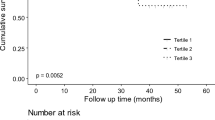Abstract
Background
Selectivity index (SI) of proteinuria, calculated using the clearance ratio of immunoglobulin G to transferrin, predicts the response to glucocorticoids in patients with nephrotic syndrome. However, there is disagreement regarding the suitability of SI. Therefore, alternate indices should be considered. This study investigated whether or not selectivity index protein fraction (SIPF) was inferior to SI for the prediction of the response to glucocorticoids.
Methods
Forty-nine patients with nephrotic syndrome were evaluated. On the basis of molecular weight and protein fraction, as an inexpensive substitute for SI, the clearance ratio of the albumin to γ fractions measured in serum and urine protein fractions was defined as SIPF. The quality of SIPF was examined. Moreover, the best cutoff value of SIPF was determined; and SIPF distribution, according to histopathological diagnosis by renal biopsy, was examined.
Results
SIPF was strongly correlated with SI (r = 0.79, P < 0.001). The area under the receiver operating characteristic (ROC) curve of SIPF and SI was not significantly different (P = 0.18). The best cutoff value of SIPF was 0.45. In the group with SIPF > 0.45, only two patients with minimal change disease (MCD) achieved complete remission. In the group with SIPF ≤ 0.45, all patients with MCD achieved complete remission, although eight patients with other histopathological diagnoses did not achieve complete remission.
Conclusions
Analysis of protein fractions as a substitute for SI may be useful for predicting response to glucocorticoids in patients with nephrotic syndrome.



Similar content being viewed by others
References
Cameron JS, White RH. Selectivity of proteinuria in children with the nephrotic syndrome. Lancet. 1965;1:463–5.
Cameron JS, Blandford G. The simple assessment of selectivity in heavy proteinuria. Lancet. 1966;2:242–7.
Blainey JD, Brewer DB, Hardwicke J, Soothill JF. The nephrotic syndrome. Diagnosis by renal biopsy and biochemical and immunological analyses related to the response to steroid therapy. QJM. 1960;29:235–56.
Soothill JF. Estimation of eight serum proteins by a gel diffusion precipitin technique. J Lab Clin Med. 1962;59:859–70.
Joachim GR, Cameron JS, Schwartz M, Becker EL. Selectivity of protein excretion in patients with the nephrotic syndrome. J Clin Invest. 1964;43:2332–466.
Abdurrahman MB, El Sheikh OK, Elidrissy AT, Al Kahtani WM, Lambourne A. Proteinuria selectivity index in Saudi children with nephrotic syndrome. Ann Clin Biochem. 1989;26:492–5.
Philippon C, Laurent J, Vivien P, Weil B, Lagrue G. Proteinuria selectivity: description of a new index. Pathol Biol (Paris). 1990;38:723–6.
Shoji H, Kimura S, Matsui M, Suehisa E, Hidaka Y. Evaluation of fully automated capillary zone electrophoresis with the Sebia Capillarys 2 System. Japanese Journal of Clinical Laboratory Automation. 2014;39:378–85 [in Japanese].
Fujimoto S, Hara S, Sato Y, Yamada K, Hisanaga S, Eto T. Nephrotic syndrome caused by membranous nephropathy: response to a short course of cyclophosphamide alternating with prednisolone. Intern Med. 2004;43:30–4.
Hasegawa T, Suzuki K, Kaneko Y, Takeuchi T. Proteinuria selectivity index as a prognostic biomarker in lupus nephritis. Lupus. 2017;26:656–60.
Ellis D, Buffone GJ. Protein clearances and selectivity determinations in childhood nephrosis: a reappraisal. Clin Chem. 1981;27:1397–400.
Lagrue G, Laurent J, Robeva R, Laurent G, Philippon C. Proteinuria selectivity index: prognostic value in idiopathic nephrotic syndromes. Ann Med Interne. 1991;142:249–53.
Laurent J, Philippon C, Lagrue G, Laurent G, Weil B, Rostoker G. Proteinuria selectivity index-prognostic value in lipoid nephrosis and related diseases. Nephron. 1993;65:185–9.
Nakayama M, Katafuchi R, Yanase T, Ikeda K, Tanaka H, Fujimi S. Steroid responsiveness and frequency of relapse in adult-onset minimal change nephrotic syndrome. Am J Kidney Dis. 2002;39:503–12.
Hosogaya S, Kume S, Fujita K, Sakurabayashi I. Quality control in electrophoretic determination of protein fractions with cellulose acetate membrane. Physico-chemical Biology. 1997;41:127 [in Japanese].
Acknowledgements
The authors would like to thank Enago (www.enago.jp) for the English language review.
Funding
None.
Author information
Authors and Affiliations
Corresponding author
Ethics declarations
Conflict of interest
All the authors have declared no competing interest.
Ethical approval
All procedures performed in studies involving human participants were in accordance with the ethical standards of the institutional committee at which the studies were conducted (IRB Approval Number 30-15) and with the 1964 Helsinki Declaration and its later amendments or comparable ethical standards.
Additional information
Publisher’s Note
Springer Nature remains neutral with regard to jurisdictional claims in published maps and institutional affiliations.
Electronic supplementary material
Below is the link to the electronic supplementary material.
About this article
Cite this article
Nakamura, J., Nagatoya, K., Fujii, N. et al. New selectivity index calculated using protein fraction as a substitute for the conventional selectivity index. Clin Exp Nephrol 23, 1196–1201 (2019). https://doi.org/10.1007/s10157-019-01753-2
Received:
Accepted:
Published:
Issue Date:
DOI: https://doi.org/10.1007/s10157-019-01753-2




